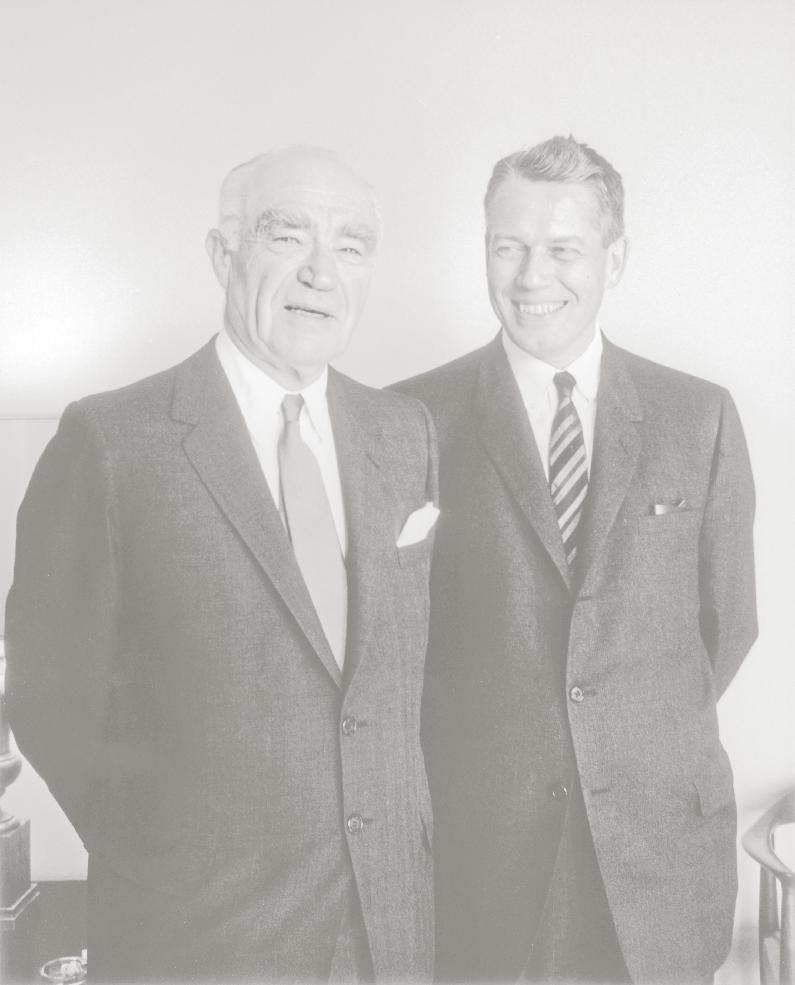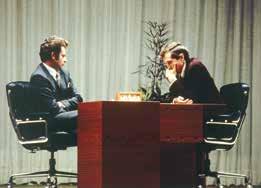
6 minute read
Time Triumphant
When Henry Luce moved his company into 1271 Sixth Avenue early in 1960, magazines were still the big thing, accounting for 86 percent of corporate revenues. A decade later, that share had shriveled to half, as faster-growing businesses outpaced stalwarts including Time, Fortune, Life, and even the relatively new Sports Illustrated. Four decades after cofounding Time Inc., Henry Luce stepped down as its editor in chief on April 16, 1964, calling it “a good moment.” By then, his baby had matured into the world’s largest magazine publisher.


1960 1961 1962 1963 1964 1965 1966

Crowds massed out in front of 1271 in 1962, hoping to glimpse John Glenn and the six other Project Mercury astronauts on the scene to celebrate a long string of Life cover stories.

In the dead of winter in 1964, Sports Illustrated released its first “Swimsuit Issue.”
Newsstand sales rocketed. So did
subscription cancellations. Henry Luce, 69, died at home in Phoenix, Arizona on February 28, 1967, 38 years— nearly to the day—after the demise of Briton Hadden, his erstwhile classmate,
kindred spirit, and cofounder. To mark the moment, Time ended its unbreach-
able ban on running cover stories about the deceased in the March 10, 1967, issue.
In 1968, the growth story shifted to the company’s big thrust into book publishing, as it snapped up venerable Little, Brown and Company and expanded TimeLife Books. In 1972, Money became the first addition to the magazine roster since SI’s 1954 debut, but that year also brought a major setback. In the final issue of the year, Life quietly announced that it was suspending publication—a victim of another picture-centric medium, television.

At the World Chess Championship in Reykjavík in 1972, American grandmaster Bobby Fischer faced Russian foe Boris Spassky. Both insisted on sitting in posh executive chairs designed in 1959 by Charles Eames for the Time & Life lobby. Two were flown in (and Fischer won, comfortably). In the November 12, 1973, issue
of the magazine, Time itself made news by breaking its 50-year run of no editorials with an impassioned call for the resignation of President Richard Nixon. A special “The Healing Begins” issue nine months later, after Nixon’s resignation, racked up newsstand sales of 527,000 copies, the most ever.
1968 1969 1970 1971 1972 1973 1974




In 1969, the Time-Life Exhibition
Center just inside the tower’s north entrance opened the Man to the Moon show, which spilled out onto the plaza where crowds gawked at a 37-foot-tall model of the Saturn V rocket next to a
23-foot-long Lunar Module. Meanwhile in 1972, in a little-noticed move, the company bought a small stake in a fledgling pay-TV operator that it rechristened Home Box Office. Three years later, HBO broke new ground, becoming the first network to broadcast via satellite. This gave Time Inc. a pioneer’s edge that it honed by creating dramatic content that drew hordes of new subscribers. HBO’s first-ever movie broadcast was the Henry Fonda–Paul Newman picture Sometimes a Great Notion.

A year later, Life alum Dick Stolley started People, the company’s 14th magazine. It boasted a circulation of 1 million, but reviews
were mixed, with William Safire of
the New York Times lambasting it as “vacuous” and “demeaning.”
cancellations at 187—a new Swimsuit Issue
record—due to the revealing beach looks of models Maria João and Cheryl Tiegs, who famously sported a fishnet suit. In 1987, Sports Illustrated special contributor George Plimpton followed up his decades-earlier stints pitching with the Yankees and quarterbacking with the Lions with “The Curious Case of Sidd Finch,” a joke for SI’s April Fools’ Day issue that laid bare the inside story of Siddhartha Finch, Buddhist monk turned Mets 168 mph fastballer.


1978 1979 1980 1981 1982 1983 1984 1985 1986
In 1986, more than 50
years after agreeing to form Rock–Time Inc. to jointly build and own 1271 Avenue of the Americas, Time Inc.
sold its stake back to Rockefeller Group.

By 1982, video had become the company’s top source of operating income, thanks in large part to HBO and its then 11 million paid subscribers around the world. A year later, having outgrown its longtime quarters on 1271’s 15th and 16th floors, HBO decamped to a building of its own, down Sixth Avenue on the corner of West 42nd Street. There it went on to bring the world such shows as Sex in the City, The Sopranos, and Game of Thrones.
In the early 1990s, the company continued to add new titles to its magazine roster, including Martha Stewart Living, Entertainment Weekly, and Vibe. In 1996, the company got even bigger, swallowing Turner Broadcasting System, Inc., founder in 1980 of Cable News Network. For four years beginning in 2002, CNN’s American Morning news show aired from 1271.


Three Greenpeace demonstrators scaled the building early one morning in 1994, unfurling a 50-foot banner protesting Time’s use of chlorine-bleached paper.
1988 1989 1990 1991 1992 1993 1994 1995 1996


In what many called Time Inc.’s biggest move since its founding, the company made a deal in 1989 that ranked as a literal name-changer. It merged with the entertainment company Warner Communications, a longtime Rockefeller Center neighbor, whose holdings included Warner Bros. Pictures. The combined entity, Time Warner, overnight became the world’s largest media company, with $10 billion in revenues. America’s bestselling newsmagazine got its own star treatment in the winter of
1991, when an 18-person camera-wielding platoon from cable network C-SPAN
spent five days roaming Time’s lair, chronicling the birth of one issue.
In a 1995 piece, reviewer Florence Fabricant mentioned a rumor that the Tower Suite restaurant on the 48th and 49th
floors was the first to have servers greet diners with “Hi, my name is Jennifer, and I’ll be your waiter tonight.”
In 2010, the ad agency at the center of the hit television show Mad Men moved to the Time & Life Building. Sterling Cooper Draper Pryce spread its wings on 34, Time Inc.’s old executive floor, but 1271’s lobby, plaza, and views got their own star turns. The New York Times praised Mad Men’s new home as the “perfect location for an upstart firm nurturing an image of being cutting edge.” The New York Observer predicted the new “tenant” would make the building “hip.”
The publisher was acquired by Des Moines, Iowa–based Meredith Corporation in January 2018 for $2.8 billion.
Time Inc. was

spun off from Time Warner

in 2014.
2010 2011 2012 2013 2014 2015 2016 2017 2018
In 2017, Time Inc.
moved downtown to
225 Liberty Street.
Hollywood mashed up James Thurber’s Walter Mitty character with George Plimpton—seen by many as Mitty’s real-life inspiration—in the 2013 film The Secret Life of Walter Mitty. Ben Stiller played the title role, a daydreaming Life photo editor laboring at 1271 in the magazine’s waning days.











